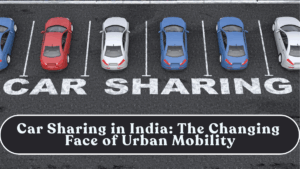As India’s cities become increasingly congested, car-sharing is emerging as a sustainable and smart mobility solution. The country’s growing urban population, coupled with rising fuel prices and limited parking, is driving demand for shared, on-demand, and subscription-based vehicle access. By 2025, India’s car-sharing market is valued at over $1.5 billion, and is projected to grow at nearly 25% annually.

The Rise of Car Sharing in India
Car sharing is redefining how Indians view vehicle ownership. Instead of buying a car, urban consumers — especially millennials and professionals — are choosing to access mobility when needed.
Leading platforms like Zoomcar, Revv, Myles, and QuickRide have created ecosystems where users can rent cars hourly, daily, or monthly through mobile apps.
Key drivers behind this boom:
-
High cost of ownership in metros.
-
Increased smartphone penetration and digital payments.
-
Environmental awareness and shift toward sustainable living.
-
Government incentives for shared and electric mobility adoption.
How Car Sharing Works
The typical car-sharing model allows users to book, unlock, and drive cars via smartphone apps.
-
Cars are parked at designated hubs or residential clusters.
-
Users can select vehicles based on duration, type, and price.
-
Payments are digital, and vehicles are GPS-tracked for security.
Modern platforms are also integrating EVs and hybrid cars to reduce emissions and operating costs, aligning with India’s clean mobility goals.
Why Urban India Is Choosing Car Sharing
| Factor | Impact |
|---|---|
| Affordability | 60–70% cheaper than owning a car in big cities |
| Flexibility | Rent by the hour or day for personal or work needs |
| Sustainability | Reduces total vehicles on road, cutting emissions |
| Accessibility | Easily available through apps and citywide hubs |
| No Maintenance | Users avoid repairs, taxes, and insurance hassles |
According to NITI Aayog, every shared vehicle can replace up to 10 private cars, saving road space and lowering congestion in urban centers.
Major Car Sharing Platforms in India
-
Zoomcar: India’s first and largest self-drive car platform with presence in 45+ cities.
-
Revv: Subscription-based model allowing long-term flexible car ownership.
-
Myles: Offers hourly and daily rentals across metros.
-
BluSmart: 100% electric ride-hailing service expanding into car-sharing zones.
-
QuickRide: Peer-to-peer model enabling users to share rides within communities.
Together, these platforms are reshaping India’s perception of convenience, ownership, and sustainability.
Government Support and Policy Framework
The Indian government is actively promoting shared mobility through policies like:
-
National Urban Transport Policy (NUTP): Encourages multimodal integration and shared services.
-
FAME II Scheme: Provides incentives for electric shared fleets.
-
Vehicle Scrappage Policy: Reduces congestion by phasing out older vehicles.
-
EV Infrastructure Development Plan: Prioritizes shared EV fleets with dedicated charging zones.
Several state governments, including Delhi, Maharashtra, and Karnataka, have drafted Shared Mobility Guidelines to streamline operations and safety.
The Role of EVs in Car Sharing
Electric vehicles are becoming a key enabler of sustainable car sharing. Platforms like BluSmart and Zoomcar Electric are already deploying EV fleets to reduce costs and pollution.
-
EVs cut operating costs by 40% compared to petrol cars.
-
Central and state governments offer subsidies for shared electric mobility.
-
Fast-charging stations are being installed near car-sharing hubs.
This integration aligns with India’s Net Zero 2070 goal and promotes a cleaner transportation ecosystem.
Challenges Facing Car Sharing in India
Despite rapid adoption, several challenges remain:
-
Low infrastructure support in smaller cities.
-
Vandalism and misuse of shared cars in some regions.
-
Limited EV charging networks for electric fleets.
-
Cultural preference for vehicle ownership among older generations.
However, continuous innovation, stricter policies, and urban planning initiatives are steadily resolving these issues.
Future Outlook: 2025–2030
The next five years will see deeper integration between shared mobility, electric vehicles, and public transport.
-
AI-based fleet management will optimize vehicle availability.
-
Autonomous vehicle pilots could begin in controlled car-sharing networks.
-
Subscription-based car ownership will expand beyond Tier-1 cities.
By 2030, India could see over 3 million shared cars in operation, significantly cutting congestion and emissions.
Conclusion
Car sharing represents the future of smart mobility in India — a future that’s affordable, flexible, and sustainable. As more Indians embrace shared services, the concept of “owning a car” is being replaced by “using one when needed.” Backed by EV integration and government support, car sharing will play a central role in India’s journey toward cleaner and more connected cities.
FAQs
What is the difference between car sharing and ride-hailing?
Car sharing allows users to drive the car themselves, while ride-hailing involves a driver-operated vehicle.
Is car sharing cheaper than owning a car in India?
Yes. It can save up to 70% in annual costs when compared to car ownership.
Which are the top car-sharing companies in India?
Zoomcar, Revv, Myles, and BluSmart are the leading players.
Are electric vehicles used in car sharing?
Yes, several platforms are integrating electric and hybrid cars for sustainability and cost efficiency.
What is the future of car sharing in India?
Car sharing will expand rapidly with EV integration, app-based access, and government incentives, especially in Tier-1 and Tier-2 cities.
